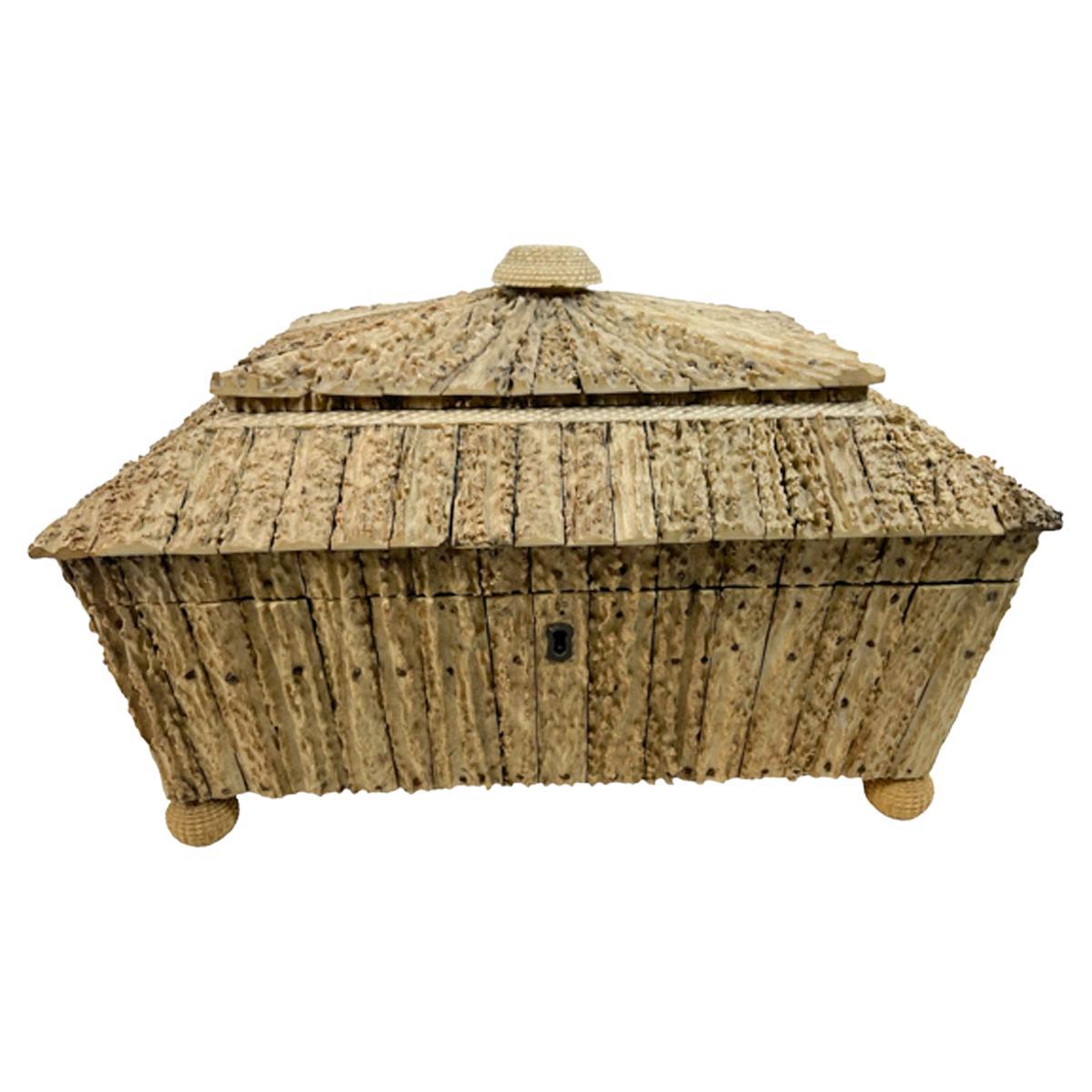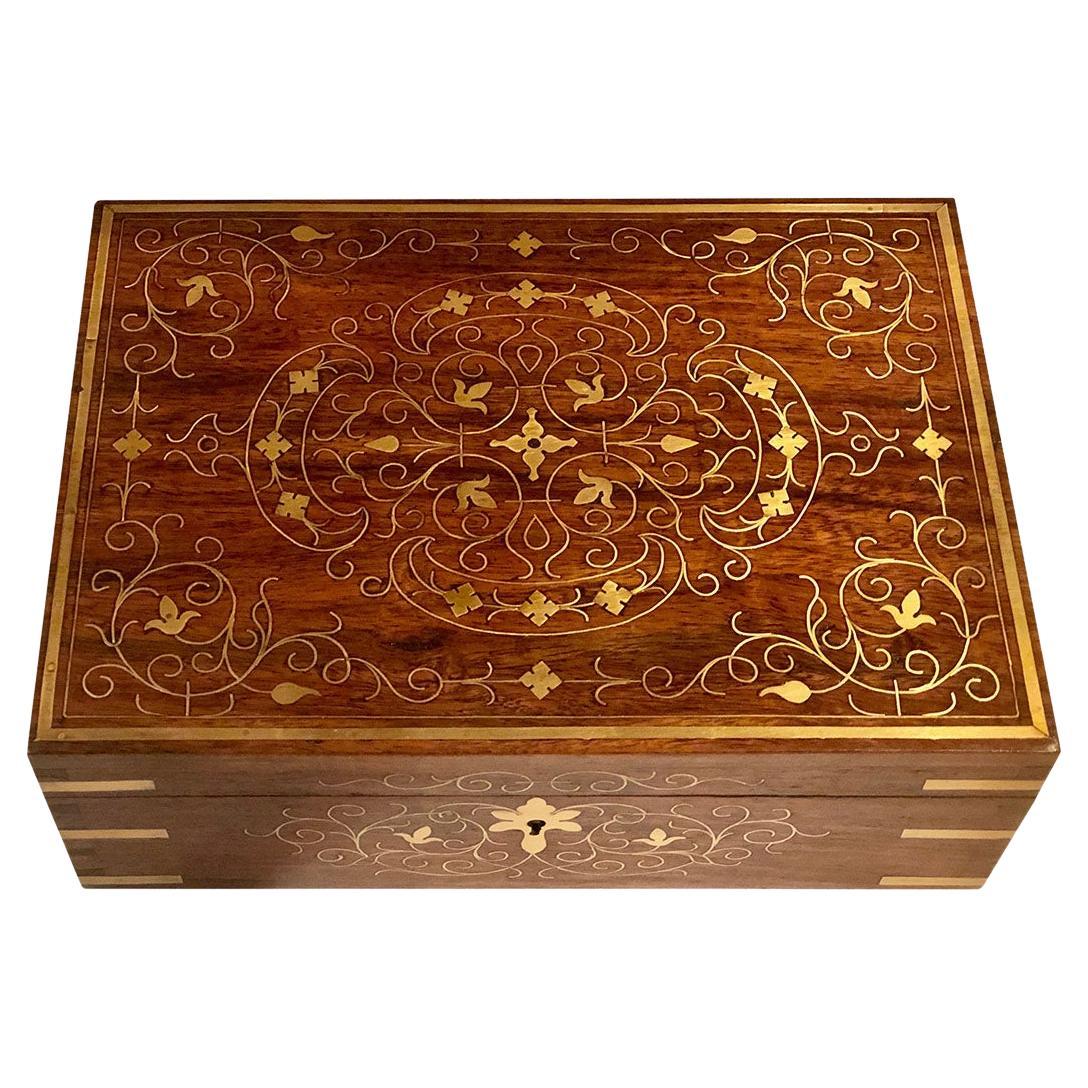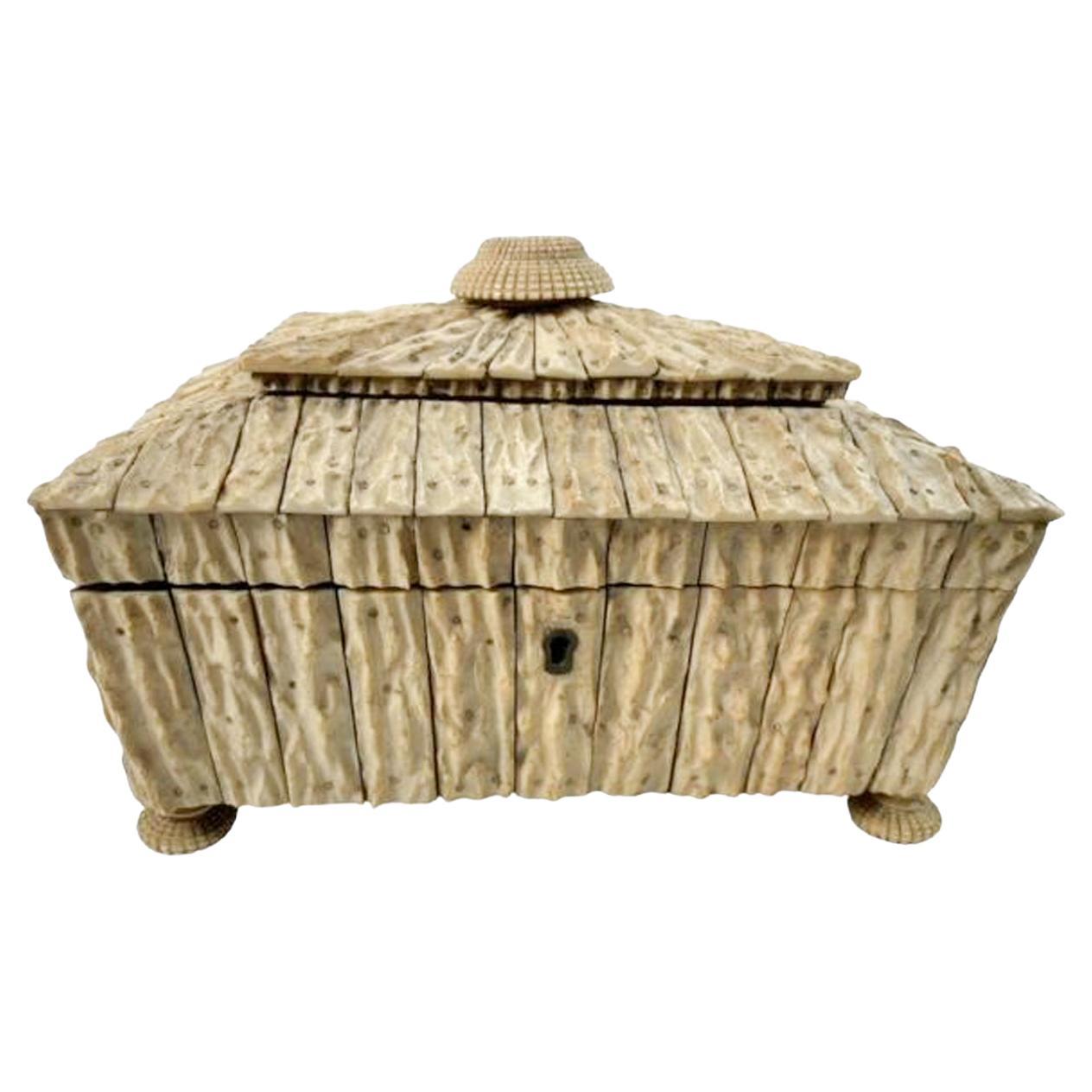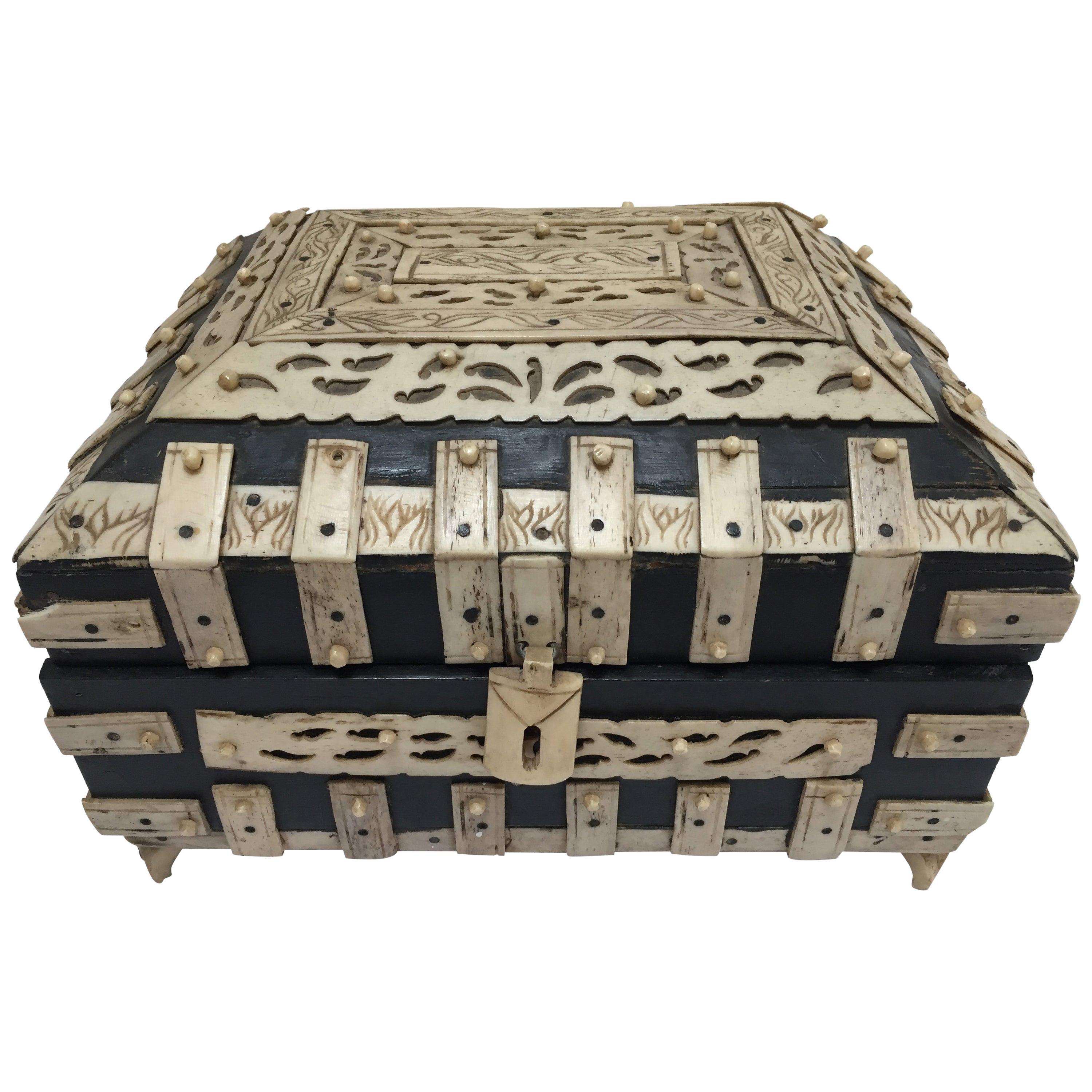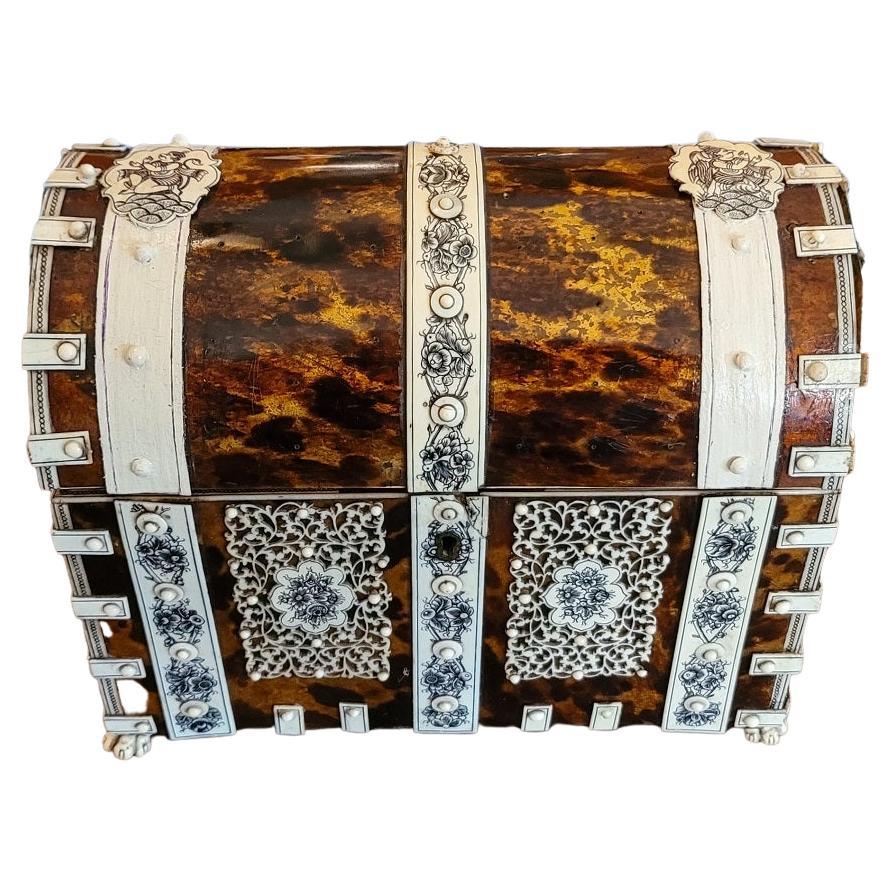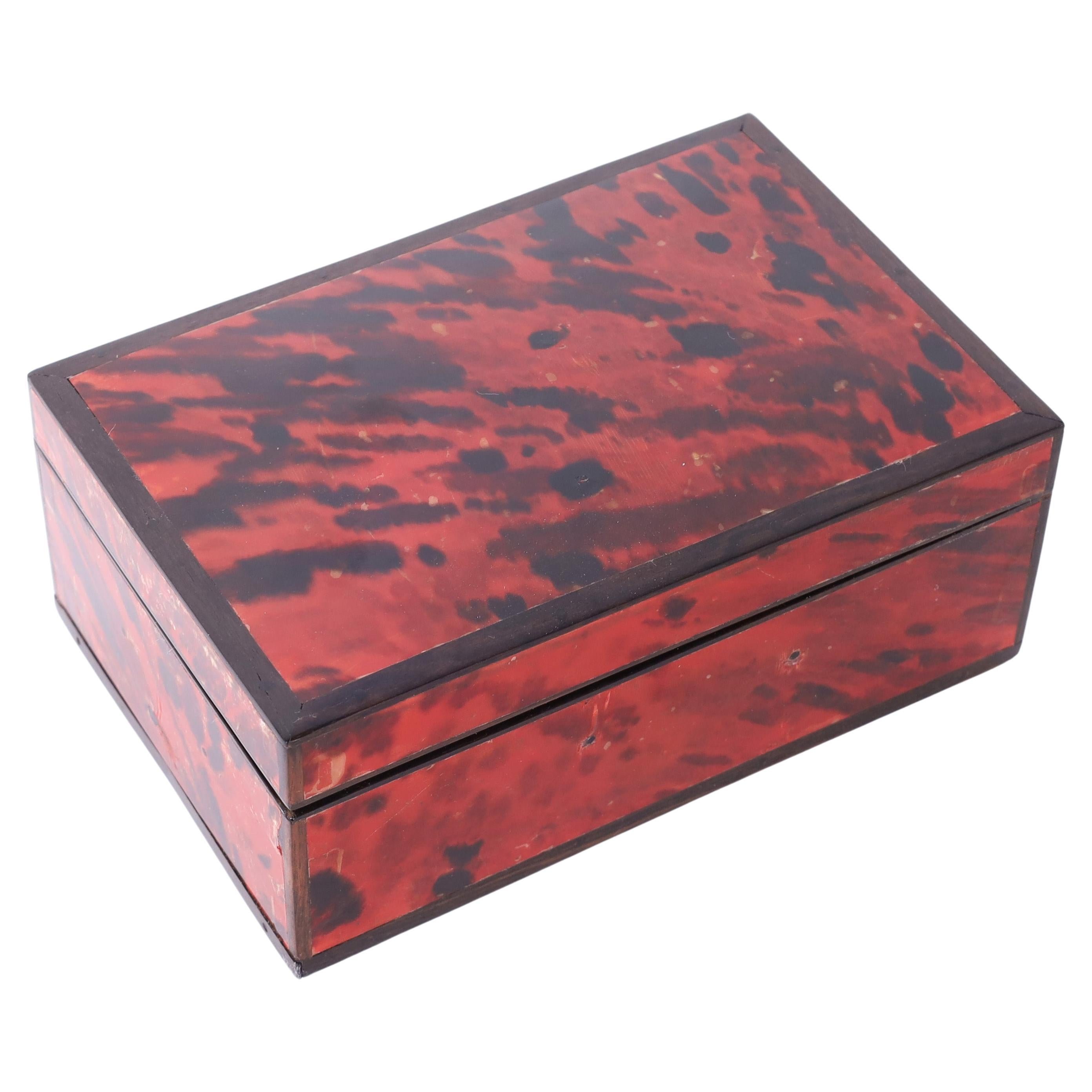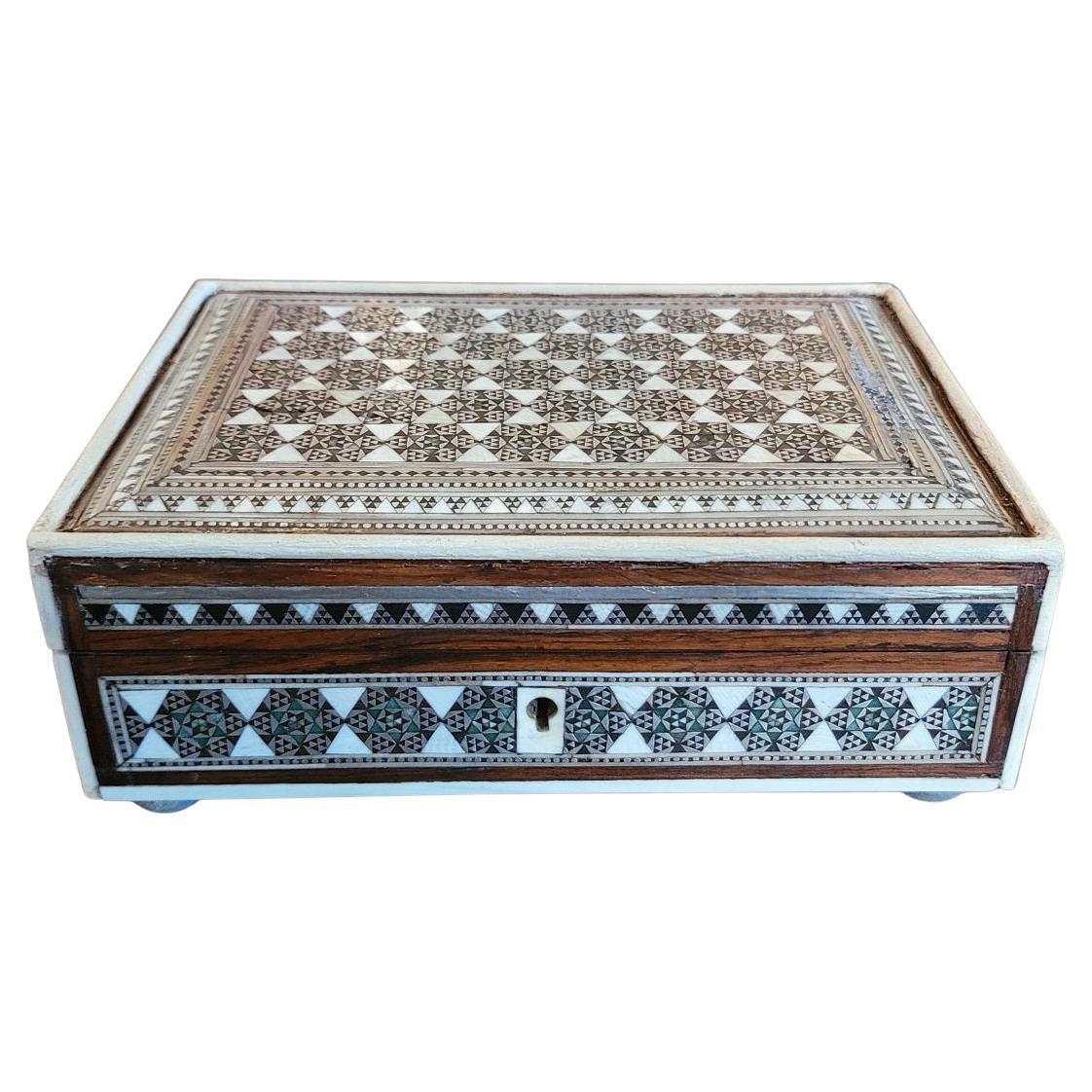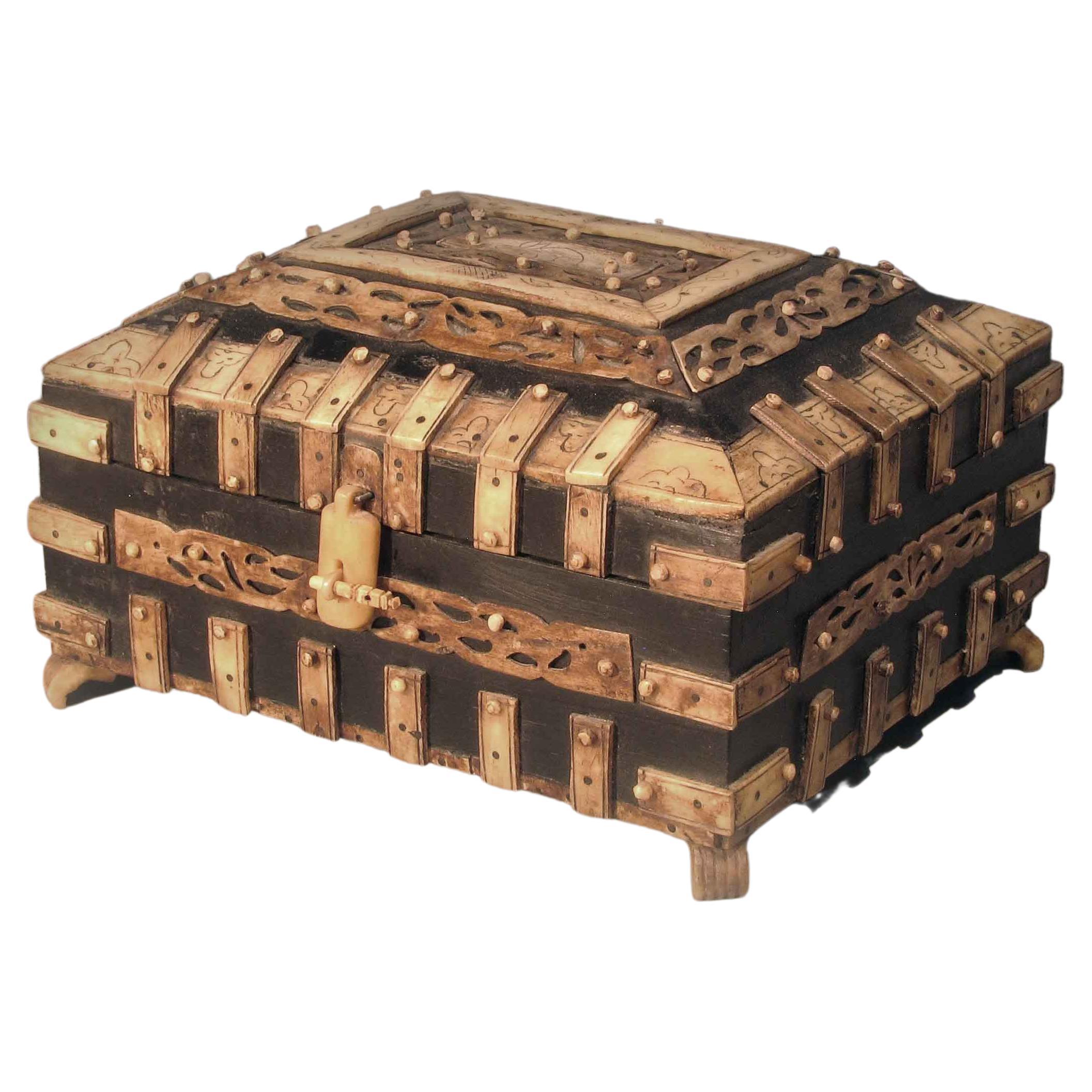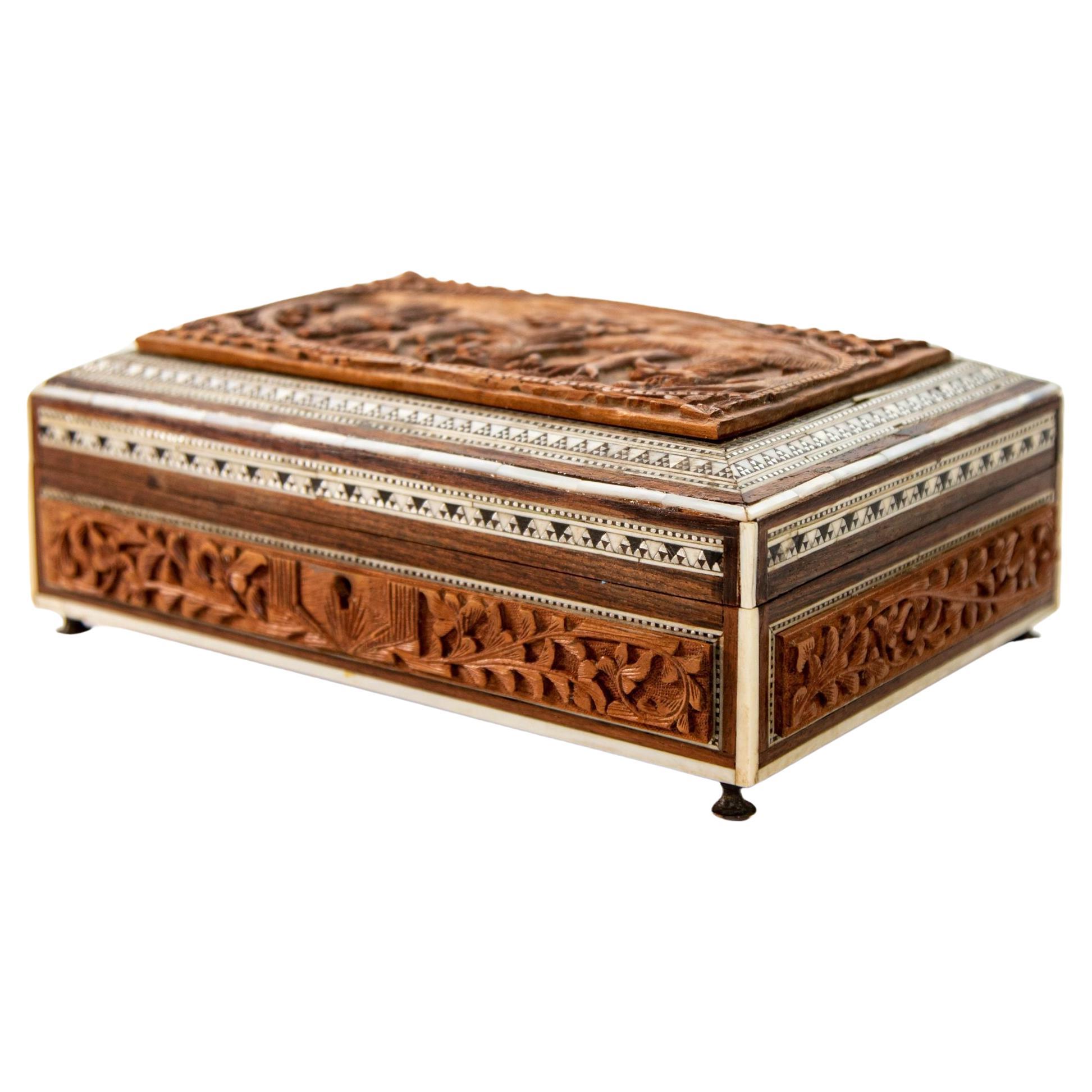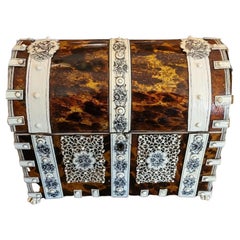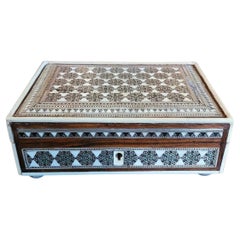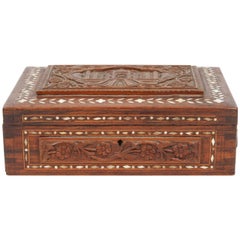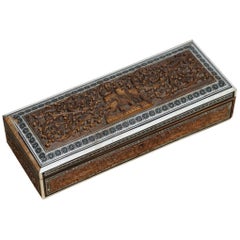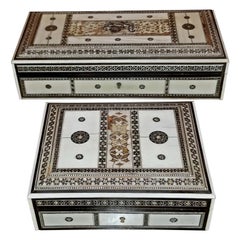
Pair of Rare 19th Century Anglo-Indian Vizagapatam Trinket Boxes
View Similar Items
Want more images or videos?
Request additional images or videos from the seller
1 of 19
Pair of Rare 19th Century Anglo-Indian Vizagapatam Trinket Boxes
About the Item
- Dimensions:Height: 2.5 in (6.35 cm)Width: 8 in (20.32 cm)Depth: 4 in (10.16 cm)
- Sold As:Set of 2
- Style:Anglo Raj (Of the Period)
- Materials and Techniques:
- Place of Origin:
- Period:
- Date of Manufacture:1870
- Condition:Wear consistent with age and use. Minor losses. Overall these boxes are in great condition. Some losses to mosaic on lid and side. Loss of piece of MOP on one box lid. Despite there delicate nature these are super.
- Seller Location:Dallas, TX
- Reference Number:1stDibs: LU3978112624312
About the Seller
4.9
Platinum Seller
These expertly vetted sellers are 1stDibs' most experienced sellers and are rated highest by our customers.
Established in 2015
1stDibs seller since 2018
349 sales on 1stDibs
More From This SellerView All
- 19C Anglo Indian Vizagapatam Bone and Shell Domed Stationery BoxLocated in Dallas, TXPRESENTING A LOVELY 19C Anglo Indian Vizagapatam Bone and Shell Domed Stationery Box – ‘Alice’s Box’. Made in Vizagapatam, India, circa 1860-80. We call this one: “Alice’s Box”! It has lived ‘a hard, well used and traveled life’, as is evident from the number of losses and repairs, as is obvious from the photos, especially to the faux ivory panels and bands to the top. The bonus to the loss of the frieze panels to the dome has a ‘bonus’, however, as their loss has revealed the most GORGEOUS faux blonde tortoiseshell underneath! The box is dome/casket shaped. The top has 3 bands, with the center one being the original. The 2 side bands are later ivorine. The faux ivory and hand-painted medallions on the domed lid, have been saved and they depict Hindu Gods, Vishnu and Shiva. The front and side panels are still in pretty good shape and are decorated with lac ink (indelible ink made from crushed beetles) depicting lovely floral designs. The domed lid open to reveal a series of open compartments for envelopes, writing paper etc. and one lidded panel for stamps. Inside the box are 2 paper labels: one probably being the original item ticket and the other with: ” Alice’s address is 272 Ashworth Ave, Toronto 4, Ontario”. Probably, the original owner? Hence, we call it ‘Alice’s Box’. What a journey/life this box has had! Made in India, made its way to Canada, back to Ireland and then to Texas! This is why, WE LOVE ANTIQUES...Category
Antique 19th Century Indian Anglo-Indian Decorative Boxes
MaterialsBone, Shell, Sandalwood
- 19C Anglo Indian Bombay MOP Sadeli Mosaic Trinket BoxLocated in Dallas, TXPRESENTING a LOVELY 19C Anglo Indian Bombay MOP (Mother of Pearl) Sadeli Mosaic Trinket Box from circa 1875-85. Gorgeously detailed and hand-crafted ‘sadeli mosaic’ inlay, from the Bombay Area, with deep greens with silver, pewter, mother of pearl, bone and ebony in geometric patterns. The box case, is made of sandalwood but completely covered in MOP, bone, faux ivory, ebony and mosaic inlay. Edged with faux ivory and banded with a different pattern of sadeli mosaic. Some minor damage to the top (repair is obvious in pics) and ivorine replacements to some edging, but it still a BEAUTIFUL BOX and of real QUALITY! The mosaic work is FABULOUS! Box opens to reveal its original blue velvet lining. It sits on 4 (recently added) silvered button feet. SADELI MOSAIC: “Anglo Indian boxes were made in India for the English residents from the early part of the 18th century. They were brought back or sent back to England usually by the people who had commissioned them. From the beginning of the nineteenth century they were imported more commercially, although not in any significant numbers until the middle decades. They were very highly valued, especially the early ones, to the extent that the designs were copied on late 19th and early 20th century tins. The ancient art of Sadeli Mosaic is said to have been introduced from Shiraz in Persia via Sind to Bombay, a long time before the Anglo Indian boxes were made. It was a technique, which required a high degree of skill and patience. It was executed very lavishly, in that the frequent cuts wasted a great amount of the precious materials used. The workmanship was however more than commensurable to the value of the materials. Ivory, silver, pewter (or other metals), wood and horn were cut into faceted rods which were bound together to form geometric patterns. When the glue has set, the rods were sliced in transverse sections. This gave the maker a number of angled circular pieces in the original pattern. Several variations of patterns could be achieved by combining the materials in different ways. The ivory was sometimes dyed green to give an extra color. The mosaic pieces in a combination of patterns, often separated by ivory, ebony, horn or silver stringing were used to veneer sandalwood boxes. In the early boxes, which date from the turn of the 18th to the 19th century, there are large panels of mosaic covering tops and sides of boxes. It took incredible skill to cover such large areas without any shakes or wavering of the pattern. The corners and joins on these boxes are impeccably matched. The makers (reputed to be Persian) of Sadeli mosaic made in the first two decades of the 19th century displayed a total understanding of the qualities of the different materials they used. They combined substances, which can expand and contract according to atmospheric conditions with others, which are hard and unyielding. The result was a sharp definition of the lines and patterns, which made up the whole design. On the early boxes the designs look deceptively simple. The fact is, they emerged from a culture, which had mastered geometry and understood how to generate a pattern from a set number of points. The patterns are so harmoniously combined that their incredible complexity is not immediately apparent. The earliest Sadeli boxes...Category
Antique Late 19th Century Indian Anglo-Indian Jewelry Boxes
MaterialsSilver
- 19th Century Anglo-Indian Spice or Tea Caddy with Silver MountsLocated in Dallas, TXPRESENTING A GORGEOUS 19C Anglo Indian Rosewood Caddy with Silver Mounts. Really nice and unusual, 19th Century Anglo-Indian Spice or Tea Caddy, from cir...Category
Antique Late 19th Century Indian Anglo Raj Tea Caddies
MaterialsSterling Silver
- 19C Anglo Ceylonese Specimen Wood Trinket BoxLocated in Dallas, TXPRESENTING A BEAUTIFUL and RARE 19C Anglo Ceylonese Specimen Wood Trinket Box. Made in ‘Galle’, Ceylon (now Sri Lanka) circa 1860-80. Made for the ex...Category
Antique 19th Century Sri Lankan Anglo-Indian Jewelry Boxes
MaterialsBone, Hardwood, Ebony, Sandalwood
- 19C Anglo Indian Vizigapatam Stamp BoxLocated in Dallas, TXPresenting an absolutely gorgeous and very rare 19C Anglo Indian Vizigapatam stamp box. Made in Colonial India (the Time of the Raj) circa 1860. Prob...Category
Antique Mid-19th Century Indian Anglo-Indian Decorative Boxes
MaterialsBone, Shell
- 19th Century Samson Paris Porcelain Trinket BoxBy Samson & CieLocated in Dallas, TXPresenting a gorgeous French 19th century Samson Paris Porcelain Trinket Box probably by Edme Samson. Marked on the base with “Made in France” and unmistakably in the style and manner of Samson. The lid features hand painted floral bouquets on an ivory porcelain background with gold edging, surrounded by a sky blue lid with gold web or crackling effect.. The lid is hinged and the lid and base are edged in floral gilt metal mounts with Fleur De Lis clasp. It sits on 4 gilt metal or ormolu feet. The sides are likewise hand decorated. This wonderful antique hand painted box is just bursting with History. Inspired by Edme Samson of Samson & Co., Paris. we believe (based upon the markings and natural aging) that it was made between 1880– 1890 in France and was meant to resemble an antique of a much earlier period. It is very similar to Sevres pieces with it’s color, decoration and design. Samson specialized in reproducing antiques from the 1600 and 1700s. One of his most interesting works was his Heraldic or Armorial pieces. With this medium sized box, he was not only copying the larger porcelain caskets or coffin boxes...Category
Antique Late 19th Century French Louis XVI Jewelry Boxes
MaterialsOrmolu
You May Also Like
- 19th Century Anglo-Indian Vizagapatam Antler Veneered Sewing / Work BoxLocated in Chapel Hill, NCA fine Vizagapatam made antler veneered sewing / work box having tapered sides and a double tiered four-slope lid with a carved finial and all raised on four turned feet. The interio...Category
Antique Mid-19th Century Indian Anglo-Indian Decorative Boxes
MaterialsAntler, Wood
- 19th Century Anglo-Indian Mughal BoxLocated in North Hollywood, CA19th century Anglo-Indian Mughal wood box, inlaid and hand carved with the Taj Mahal and some flowers all around. Jewelry box, Anglo-Raj box from India in great condition. Nice Mughal Bombay Box...Category
Antique Late 19th Century Indian Anglo Raj Decorative Boxes
MaterialsSandalwood
- 19th Century Anglo Indian Vizagapatam Carved Sandalwood Box Micro Mosaic InlaysLocated in GBWe are delighted to offer for sale this lovely 19th century Anglo-Indian Vizagapatam carved sandalwood and inlaid box Mid-19th century Anglo-Indian Vizagapatam carved sandalwood box...Category
Antique 19th Century Indian Anglo-Indian Decorative Boxes
MaterialsWood
- 19th Century Anglo Indian Rosewood BoxLocated in Tampa, FLAn Anglo Indian Rosewood box circa late 19th century. The gilt design of florals and scrolls on the top carriers through to all four sides so...Category
Antique 1890s Indian Anglo-Indian Decorative Boxes
MaterialsRosewood
- Anglo-Indian Stag Horn Veneered Sewing / Work Box From VizagapatamLocated in Chapel Hill, NCAnglo-Indian stag horn veneered sandalwood sewing or work box with a sloped two-tier lid having a carved finial above tapered sides and raised on compressed ball feet. The interior w...Category
Antique Mid-19th Century Indian Anglo Raj Decorative Boxes
MaterialsBone, Antler, Wood
- Anglo-Indian Vizagapatam Bombay Mughal Style Footed Box With Bone OverlayLocated in North Hollywood, CANice and unusual Indian Mughal style large decorative box, filigree and carved horn. Anglo-Indian footed domed box with exceptional engraved details throughout with filigree and carved veneered bone plaques with arabesque carving. Vizagapatam, late 19th century. History of the Anglo-Indian Boxes Beginning in the early part of the 18th century, Indian artisans made what came to be known as Anglo-Indian boxes for the English residents living in India, who eventually brought or sent them back to England. At the beginning of the 19th century, India began exporting these boxes commercially, although not in any significant numbers until the 1850s. People valued them so highly that manufacturers of tins copied the designs on them in the late 19th and early 20th century. Anglo-Indian boxes fall into four groups: Rosewood or ebony boxes inlaid; sandalwood boxes veneered; sandalwood boxes covered with Sadeli mosaic; and carved boxes often combined with Sadeli mosaic/ The first two categories came from Vizagapatam in East India while the last two came from Bombay in West India. English traders discovered the rich woods and intricate workmanship of Indian artisans, so colonial government officials began to recognize the work of the Indian artists and craftsmen as a source for satisfying the need for furniture and boxes, which would both serve to enhance English households in India. This gave rise to the cabinetmaking workshops in Vizagapatam between Calcutta and Madras. Craftsmen made the first boxes to be decorated with Sadeli mosaic of rosewood or ebony, incised to give further definition to the decoration, directly inlaid into the wood. The shape of the early boxes was either sloping at the front with a flatter section at the back, reminiscent of English writing slopes, or rectangular. Artisans inlaid the borders with stylized floral scrolls and the centers with a single floral motif following a circular or oval symmetrical or asymmetrical pattern. The edging was ornamental and protective, both helped protect the end grain against the weather. Made in Vizagapatam, situated on the south east coast of India, near Madras These exotic boxes...Category
Antique Late 19th Century Indian Anglo Raj Decorative Boxes
MaterialsWood
Recently Viewed
View AllMore Ways To Browse
Ivory Inlay Box
India Sandalwood
Sandalwood Box
Indian Ivory Box
Set Of Bone Inlaid
Large Trinket Box
Antique Sandalwood Box
Floral Trinket Box
Stone Trinket
Carved Sandalwood
Inlaid Trinket Box
Vizagapatam Furniture
Pair Trinket
Large Mosaic Box
Anglo Indian Vizagapatam
Stone Trinket Box
Anglo Indian Silver Box
Vizagapatam Box
